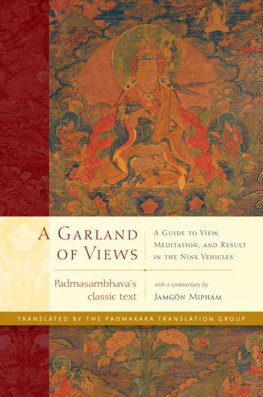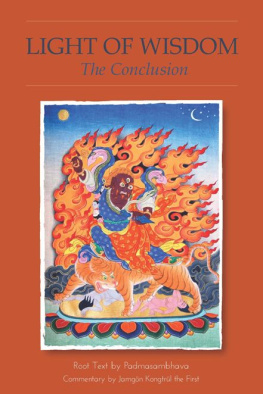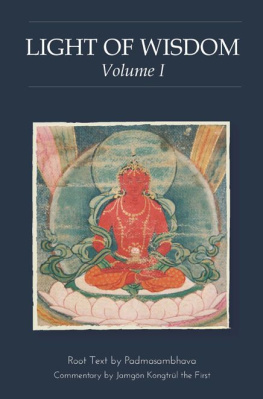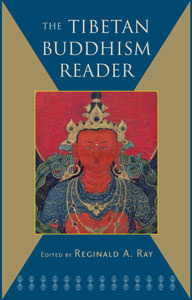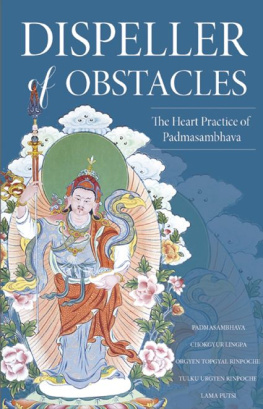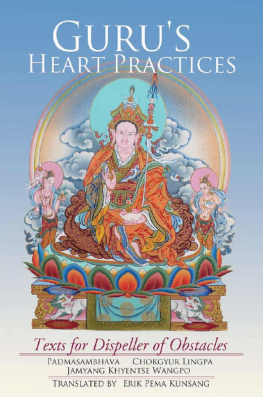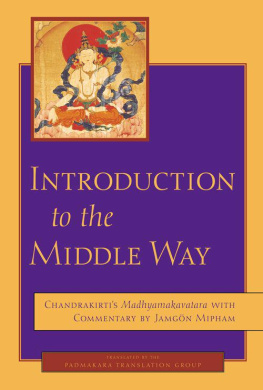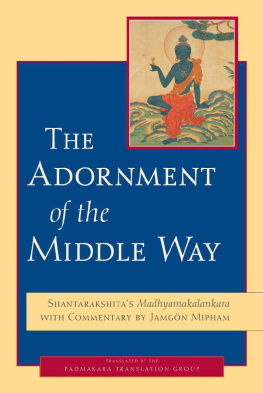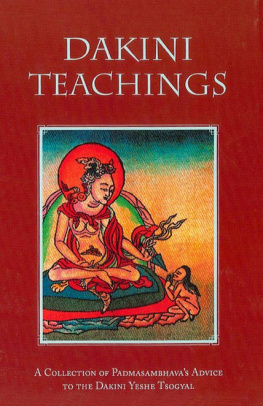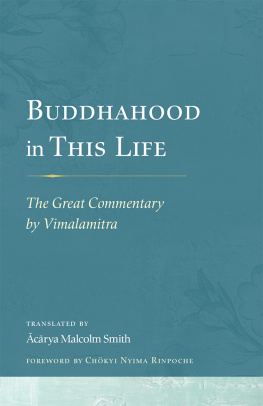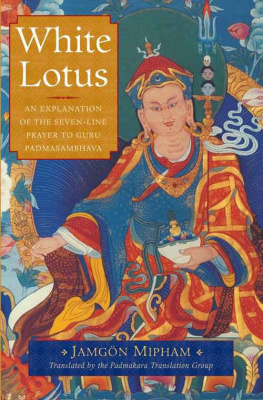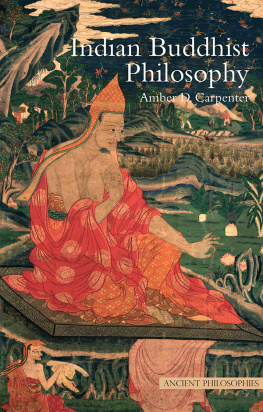This unique and classic text composed by Guru Padmasambhava has been transmitted, studied, and revered by Tibetans for centuries. A pithy guide to the View and the nine spiritual vehicles, culminating in Dzogpachenpo, the Great Perfection, it is accompanied by indispensable clarifications from the peerless Mipham Rinpoche. It must be read by anyone seeking a deeper understanding of the ancient tradition of Tibets extraordinary Buddhist wisdom.
Sogyal Rinpoche, author of The Tibetan Book of Living and Dying
A Garland of Views is a great manual for traveling the Dzogpachenpo path of the early Translation School of Tibetan Buddhism. With detailed insights, it elucidates how all the yanas are stepping-stones to the summit of Great Perfection, the realization of Samantabhadra. This is the way of great teachers such as Guru Padmasambhava, Vimalamitra, and Longchenpa, and what they have taught throughout history. I am delighted that Padmakara has made a text like this available to Western audiences so readers can comprehend the extensive teachings on the Dzogpachenpo lineage. It will greatly serve the transplantation of buddhadharma in the West.
Dzigar Kongtrl, author of Its Up to You
ABOUT THE BOOK
A Garland of Views presents both a concise commentary by the eighth-century Indian Buddhist master Padmasambhava on a chapter from the Guhyagarbha Tantra on the different Buddhist and non-Buddhist philosophical views, including the Great Perfection (Dzogchen), and an explicative commentary on Padmasambhavas text by the nineteenth-century scholar Jamgn Mipham (18461912). Padmasambhavas text is a core text of the Nyingma tradition because it provides the basis for the system of nine vehicles (three sutra vehicles and six tantra vehicles) that subsequently became the accepted way of classifying the different Buddhist paths in the Nyingma tradition. Miphams commentary is the one most commonly used to explain Padmasambhavas teaching. Mipham is well known for his prolific, lucid, and original writings on many subjects, including science, medicine, and philosophy, in addition to Tibetan Buddhist practice and theory.
Sign up to receive weekly Tibetan Dharma teachings and special offers from Shambhala Publications.

Or visit us online to sign up at shambhala.com/edharmaquotes.

Buddha kyamuni

Guru Rinpoche

A G ARLAND OF V IEWS

A G UIDE TO V IEW, M EDITATION, AND R ESULT IN THE N INE V EHICLES
Padmasambhavas classic text
with a commentary by
J AMGN M IPHAM
TRANSLATED BY THE PADMAKARA TRANSLATION GROUP

SHAMBHALA
BOSTON & LONDON
2015
Shambhala Publications, Inc.
Horticultural Hall
300 Massachusetts Avenue
Boston, Massachusetts 02115
www.shambhala.com
2015 by the Padmakara Translation Group
Cover design: Gopa & Ted2, Inc.
All rights reserved. No part of this book may be reproduced in any form or by any means, electronic or mechanical, including photocopying, recording, or by any information storage and retrieval system, without permission in writing from the publisher.
Library of Congress Cataloging-in-Publication Data
Padma Sambhava, approximately 717 to approximately 762, author.
A garland of views: a guide to view, meditation, and result in the nine vehicles: Padmasambhavas classic text with a commentary by Jamgn Mipham / Translated by the Padmakara Translation Group.First edition.
pages cm.
Includes bibliographical references and index.
Translated from Tibetan.
eISBN 978-0-8348-4006-5
ISBN 978-1-61180-296-2 (hardback)
1. Rin-ma-pa (Sect)DoctrinesEarly works to 1800. I. Mi-pham-rgya-mtsho, Jam-mgon Ju, 18461912. II. Padma Sambhava, approximately 717 to approximately 762. Man ngag lta bai phreng ba. III. Padma Sambhava, approximately 717 to approximately 762. Man ngag lta bai phreng ba. English. IV. Comit de traduction Padmakara. V. Title.
BQ7950.P324M3613 2015
294.3923dc23
2015009884
The Padmakara Translation Group gratefully acknowledges the generous support of the Tsadra Foundation in sponsoring the translation and preparation of this book.
Contents
This book contains diacritics and special characters. If you encounter difficulty displaying these characters, please set your e-reader device to publisher defaults (if available) or to an alternate font.
I. Introduction
A. Explanation of the title
B. Expression of veneration
II. The main body of the text
A. Explanation of the different views
1. Explanation of non-Buddhists views
a. Brief introduction
b. Detailed explanation
i. Explanation of the unreflective and the materialists
ii. Explanation of the nihilistic extremists and eternalistic extremists
2. Explanation of Buddhists views
a. Brief introduction
b. Detailed explanation
i. Presentation of the vehicle of characteristics
A) Brief introduction
B) Detailed explanation
1) Explanation of the Listener Vehicle
2) Explanation of the Solitary Realizer Vehicle
3) Explanation of the Bodhisattva Vehicle
ii. Presentation of the Mantra Vehicle
A) Brief introduction
B) Detailed explanation
1) Presentation of Kriytantra
2) Presentation of Ubhayatantra
3) Presentation of Yogatantra
a) Brief introduction
b) Detailed explanation
i) Presentation of the outer Yogatantra
ii) Presentation of the inner Yogatantra
(A) Brief introduction
(B) Detailed explanation
(1) A general explanation of the three methods
(a) The method of generation
(b) The method of perfection
(c) The method of the Great Perfection
(2) A specific explanation of the avenues for applying the three methods
(a) The four kinds of realization
(b) The three characteristics
(c) The four branches
(d) The four stages of entering the ma ala
B. An explanation of the different kinds of yogic disciplines
1. Brief introduction
2. Detailed explanation
III. Conclusion
A. The disciples for whom these instructions were intended
B. Colophon marking the completion of the text
The great Indian master Padmasambhava is considered to be an emanation of Buddha Shakyamuni, who predicted that he would be a great propagator of the tantric teachings in this world. He was instrumental, along with other great masters, in establishing the Buddhas teachings in Tibet in the eighth century. So preeminent was his influence that ever since he has been revered in the Land of Snows as Guru Rinpoche, the Precious Teacher.
While most of the numerous teachings that he gave during his stay in Tibet were hidden as treasure by his disciples, to be rediscovered later by their emanations in accordance with the Gurus predictions, this text is unusual in that it has come down to us through the oral lineage, passed on from master to disciple over the centuries. In it, Guru Rinpoche gives an account of the different views held by the various Buddhist schools and by non-Buddhists. If we wish to attain awakening or buddhahood, adopting the right view is crucial to the practice of the path, for as Mipham Rinpoche has pointed out, it is necessary for us to see properly if our feet are to take us in the right direction. It is by gaining a knowledge of the different views that we can know which views should be rejected and which views will most benefit us in our progress on the spiritual path that leads to our becoming a buddha.
Next page
